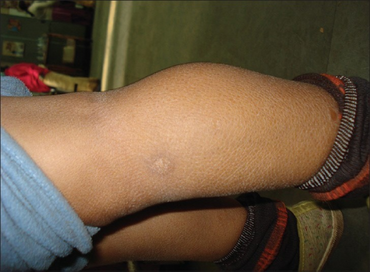Kocher–Debre–Semelaigne syndrome
| Kocher–Debré–Semelaigne syndrome | |
|---|---|
| Other names: Muscular pseudohypertrophy-hypothyroidism syndrome | |
 | |
| Hypertrophied limb-girdle muscles , as well as, dry skin | |
The Kocher–Debré–Semelaigne syndrome is hypothyroidism in infancy or childhood characterised by lower extremity or generalized muscular hypertrophy, myxoedema, short stature and cretinism.[1] The absence of painful spasms and pseudomyotonia differentiates this syndrome from its adult form, which is Hoffmann syndrome.[2]
The syndrome is named after Emil Theodor Kocher, Robert Debré and Georges Semelaigne. Also known as Debré–Semelaigne syndrome or cretinism-muscular hypertrophy, hypothyroid myopathy, hypothyroidism-large muscle syndrome, hypothyreotic muscular hypertrophy in children, infantile myxoedema-muscular hypertrophy, myopathy-myxoedema syndrome, myxoedema-muscular hypertrophy syndrome, myxoedema-myotonic dystrophy syndrome.
Kocher–Debre–Semelaigne syndrome gives infant a Hercules appearance.[3]
Signs and symptoms
The age at which child presents with KDSS may vary from new born to as late as 11 years of age. This disease is very rare as only less than 10% of children with hypothyroid myopathy develops this condition. Along with features of hypothyroidism the main additional feature is muscle hypertrophy. It can happen in any muscle of the limbs, but commonly affects the proximal muscles giving the typical Hercules appearance. Even though the muscle appears enlarged, it is weak and so the affliction is pseudo hypertrophy especially of the calf muscles.[4]
Other features are pseudomyotonia, myokymia, slow tendon reflex, slowed muscle contractions and relaxations, muscle stiffness, proximal muscle weakness and myopathy. The severity of these symptoms are determined by the period of hypothyroidism and the degree of deficiency of thyroid hormones.[5]
EMG is either normal or may show myopathic low amplitude and short motor unit's potential (MUAPS).[6] The enzymes creatine kinase is elevated usually.
Pathophysiology
The assumed cause of muscle hypertrophy in KDSS is an abnormal metabolism of carbohydrates leading to increased glycogen accumulation and increased mucopolysaccharide deposits in the muscles.[7] Yet another speculation is an excess intra cellular calcium due to ineffective reuptake into the sarcoplasmic reticulum, which causes a sustained contraction and thereby hypertrophy.[8]
In hypothyroidism the fast twitch muscle fiber is converted to slow twitch fiber, causing the slower reflex or hung up reflex. This may occur as a result of reduction in muscle mitochondrial oxidative capacity and beta-adrenergic receptors, as well as the induction of an insulin-resistant state, due to decrease in thyroid hormones.[9]
The causes for muscle weakness is said to be decrease in muscle carnitine, decreased muscle oxidation, expression of a slower ATPase in myosin chain and decreased transport across the cell membrane.[10][11]
The rigidity associated with congenital hypothyroidism may be due to abnormal development of basal ganglia.[12]
Diagnosis
In terms of the diagnosis of this condition is based on clinical features, as well as myopathic changes (screening is available via primary TSH test)[13]
Treatment
The muscle hypertrophy and other symptoms are reversible on treatment with levothyroxine.[14]
References
- ↑ Millichap, J. Gordon (2013). Neurological syndromes : a clinical guide to symptoms and diagnosis. New York, NY: Springer New York. p. 121. ISBN 9781461477860.
- ↑ Bhansali, Anil; Aggarwal, Anuradha (2016). Clinical Rounds in Endocrinology: Volume II - Pediatric Endocrinology. Springer. p. 81. ISBN 9788132228158.
- ↑ Sainani, JP (2015). Clinical Cases & Pearls in Medicine. JP Medical Ltd. p. 333. ISBN 9789351526469.
- ↑ Tullu, Milind S.; Udgirkar, Vardhaman S.; Muranjan, Mamta N.; Sathe, Shefali A.; Kamat, Jaishree R. (2003-08-01). "Kocher-Debre-Semelaigne syndrome: Hypothyroidism with muscle pseudohypertrophy". The Indian Journal of Pediatrics. 70 (8): 671–673. doi:10.1007/BF02724260. ISSN 0973-7693. Archived from the original on 2022-01-11. Retrieved 2021-03-06.
- ↑ Klein, Irwin; Mantell, Paul; Parker, Mitchell; Levey, Gerald S. (May 1980). "Resolution of abnormal muscle enzyme studies in hypothyroidism". The American Journal of the Medical Sciences. 279 (3): 159–162. doi:10.1097/00000441-198005000-00004. PMID 7424961. S2CID 11587035.
- ↑ Rajvanshi, Satyam; Rai, GopalK; Philip, Rajeev; Gupta, KK (2012). "Kocher-Debre-Semelaigne syndrome". Thyroid Research and Practice. 9 (2): 53. doi:10.4103/0973-0354.96047. ISSN 0973-0354.
- ↑ Panat, Sunil R.; Jha, Prakash Chandra; Chinnannavar, Sangamesh N.; Chakarvarty, Ankkita; Aggarwal, Ashish (March 2013). "Kocher Debre Semelaigne Syndrome: A Rare Case Report with Orofacial Manifestations". Oman Medical Journal. 28 (2): 128–130. doi:10.5001/omj.2013.33. ISSN 1999-768X. PMC 3628204. PMID 23599883.
- ↑ Pourmand, Rahman (February 2000). "Metabolic Myopathies". Neurologic Clinics. 18 (1): 1–13. doi:10.1016/s0733-8619(05)70176-6. ISSN 0733-8619. PMID 10658166.
- ↑ Benvenga, Salvatore; Toscano, Antonio; Rodolico, Carmelo; Vita, Giuseppe; Trimarchi, Francesco (August 2001). "Endocrine Evaluation for Muscle Pain". Journal of the Royal Society of Medicine. 94 (8): 405–407. doi:10.1177/014107680109400810. ISSN 0141-0768. PMC 1281637. PMID 11461987.
- ↑ Horak, Holli A.; Pourmand, Rahman (February 2000). "Endocrine Myopathies". Neurologic Clinics. 18 (1): 203–213. doi:10.1016/s0733-8619(05)70186-9. ISSN 0733-8619. PMID 10658176.
- ↑ Sinclair, Christopher; Gilchrist, James M.; Hennessey, James V.; Kandula, Manju (2005). "Muscle carnitine in hypo- and hyperthyroidism". Muscle & Nerve. 32 (3): 357–359. doi:10.1002/mus.20336. ISSN 0148-639X. PMID 15803480.
- ↑ Barrett, Kim E. (2019-01-29). Ganong's review of medical physiology. Barman, Susan M.,, Brooks, Heddwen L.,, Yuan, Jason X.-J., 1963-, Preceded by: Ganong, William F. (Twenty-sixth ed.). [New York]. p. 848. ISBN 9781260122404. OCLC 1076268769.
- ↑ RESERVED, INSERM US14-- ALL RIGHTS. "Orphanet: Muscular pseudohypertrophy hypothyroidism syndrome". www.orpha.net. Archived from the original on 14 December 2021. Retrieved 19 December 2021.
- ↑ Mehrotra, P (2002-03-01). "Kocher Debre Semelaigne syndrome: regression of pesudohypertrophy of muscles on thyroxine". Archives of Disease in Childhood. 86 (3): 224a–224. doi:10.1136/adc.86.3.224-a. ISSN 0003-9888. PMC 1719134. PMID 11861255.
External links
| Classification | |
|---|---|
| External resources |